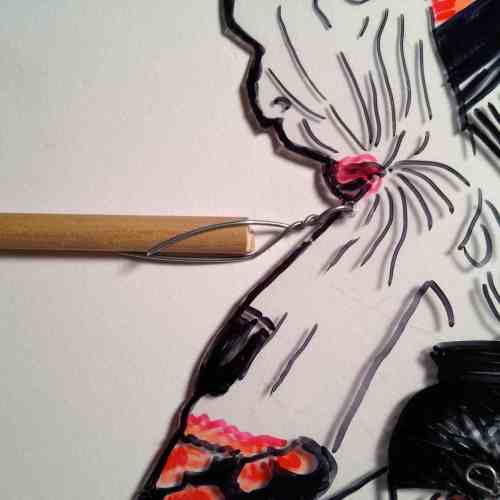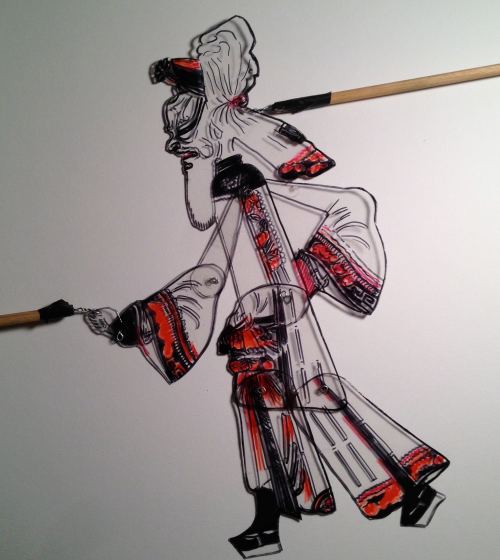The unimaginable has happened.
In the past few weeks, a strange and lucky set of events have led me to the smallest accomplishment of my life. I have just cut a set of 1”-scale traditional leather Chinese shadow puppets for display in the Art Institute of Chicago’s Thorne Miniature Rooms.
I first saw the Thorne Miniature Rooms when I was a young teen. I’m not sure how or why I was in Chicago, or even how we made our way to the legendary Institute, but the one thing I have never forgotten about were the miniature rooms: glowing boxes of exquisite smallness along mazes of darkened hallways. Once captured in their impossibility, I didn’t want to be let go.
 The Art Institute of Chicago’s Thorne Miniature Rooms: English Dining Room of the Georgian Period, 1770-90, c. 1937
The Art Institute of Chicago’s Thorne Miniature Rooms: English Dining Room of the Georgian Period, 1770-90, c. 1937
Part of the spell is their natural beauty, but much of it stems from the perfect comprehensibility of, say, a 1700 Georgian Dining room the size of a shoebox. The observer feels both godlike and humbled by the sheer reducibility of that which seems irreducible. And they are beautiful. All of these rooms are handmade by master craftsman according to the particular specifications of Mrs. James Ward Thorne. All 68 of them. Certainly, seeing these rooms so early on was instrumental in my developing fascination with all things handmade, representative and miniature.
Fast-forward some 20-odd years later and on an unsuspecting morning in October, I received an email from the keeper of the Thorne Miniature Rooms. She was looking for information about Chinese shadow puppetry! With plans to highlight their miniature Chinese room this year, they had hoped to place some traditional shadow puppets within.
My mind reeled. My eyes were wide. I might have been drooling.
What a convergence of wonderful, impossible things.
Instantly, we were in a flurry of exchanges: discussing performances, regional styles and cutting techniques. I offered to give the miniatures a try; wisely giving myself an out if the 1” scale bested me. But of course, I had to try.
{Now, in case you’re not sure, 1” scale means every foot is reduced to 1”. Or 1’=1”. For reference, this means that your laptop computer would be reduced to about 1” or 1.5” wide.}
My first attempt was, well, awful. It seemed as though my monstrously large blade miss-cut the paper-thin leather on nearly every single pass – but I couldn’t even see well enough to tell. My neck ached from crouching eye-level to the table and I was barely holding onto the cut piece with a needle tool. Impossible. Even my first attempt at painting the mangled piece of leather was hideous.
My obsession with the miniature rooms and the knowledge that someone could make those meant I had to be able to make these – this is what pushed me forward. I tried and tried again: smaller, closer, better. Or, more accurately: achier, blinder, worse. In case you’re wondering, there is no god-complex inherent in making minis. More so, the opposite is true: you simply feel like a bumbling, mitten-handed oaf, swearing to yourself the entire time.
At some point, the zen set in. The beauty of working on something so small is that time stands still. In order to work at that scale, everything else must recede. You must forget about your own size, your own weight and volume and become a smaller, quieter, more immaterial conduit for miniature to pass through you. And, somehow it did.
 Lady White Snake, 1 1/2″ tall: cowhide, string, paint
Lady White Snake, 1 1/2″ tall: cowhide, string, paint
 Lady White Snake in Shadow
Lady White Snake in Shadow
 Lady White Snake in scale with the gigantic shadow-hand!
Lady White Snake in scale with the gigantic shadow-hand!
 A bridge, 1″ tall: leather, paint
A bridge, 1″ tall: leather, paint
 The bridge in shadow
The bridge in shadow
 In perspective…such a little bridge!
In perspective…such a little bridge!
 Lady White Snake’s lover, Xuxian, 1 1/2″ scale: leather, string, paint.
Lady White Snake’s lover, Xuxian, 1 1/2″ scale: leather, string, paint.
 Xuxian in Shadow
Xuxian in Shadow
Now, as I return to the real world back from the small, everything seems large, inexact and – well – lacking exquisiteness. It’s true what they say: small is beautiful.
Thanks for reading~
(PS: The shadow puppets should be up sometime this winter)


 Lady White Snake, 1 1/2″ tall: cowhide, string, paint
Lady White Snake, 1 1/2″ tall: cowhide, string, paint

 A bridge, 1″ tall: leather, paint
A bridge, 1″ tall: leather, paint The bridge in shadow
The bridge in shadow In perspective…such a little bridge!
In perspective…such a little bridge! Lady White Snake’s lover, Xuxian, 1 1/2″ scale: leather, string, paint.
Lady White Snake’s lover, Xuxian, 1 1/2″ scale: leather, string, paint. Xuxian in Shadow
Xuxian in Shadow





































